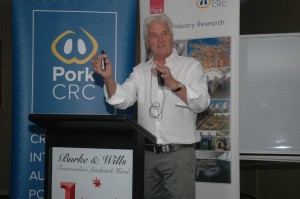Pork CRC Pointers For Successful Sow Group Housing
Australian pork producers and sows in their care are successfully transitioning to group housing as part of the concerted efforts to produce high integrity Australian pork and appropriately differentiate the product from that of overseas competitors.
Addressing 150 pork producers and industry stakeholders at the recent Pork CRC and APL ‘Successful Group Housing Systems for Dry Sows’ workshops in Toowoomba, Queensland and Melbourne, Victoria, CRC for High Integrity Australian Pork (Pork CRC) CEO, Dr Roger Campbell, described group housing the Australian way as “now virtually a done deal”.
“Most producers have made the transition and those who are now a couple of years down the track are reporting very satisfactory production levels and, it seems, improved welfare outcomes for sows.
“While the precise recipes for those successes vary slightly, the essential ingredients are providing adequate quantity and quality of space for the sows, plenty of feed availability and access, especially immediately after first mixing of sows into groups and, as is the Australian way, good stockmanship,” Dr Campbell said.
Pork CRC Subprogram Leader, Professor Paul Hemsworth of the Animal Welfare Science Centre (AWSC), University of Melbourne, said domestic pigs, just like their wild relatives, needed to establish a social order or hierarchy and this needed to be done quickly when sows were first mixed.
“Sows need adequate space to avoid other sows and research has shown that space is more important than group size when mixing sows.
“Stress will, typically, reduce from day two to nine after mixing and maximising space allowances, especially up to day two, will help reduce aggression between sows.
“Superior stockmanship is very important with group housing and being aware that if sows have recent familiarity they are likely to be less aggressive on mixing,” Professor Hemsworth said.
He added that the quality of floor space and feeding system type was also important.
Producers at the workshops generally agreed that providing plenty of feed, including perhaps multiple drops per day if floor feeding, was very important, especially when sows were first mixed in groups.
All feeding arrangements, including electronic sow feeding systems (ESFs), where sows are trained and full or shoulder stall feeding, had advantages and disadvantages.
Producers should, for example, ensure sufficient ESFs for the number of sows in the pen to minimise aggression during entry to the ESF.
Dr Jean Loup Rault, a colleague of Professor Hemsworth at AWSC, addressed the workshops, recommending that, in order to limit unwelcome aggression between sows mixed at weaning, producers should consider using feeding stalls, distinct mating stalls and make efforts to limit sexual interaction by dominant sows over submissive sows.
Chris Richards and Associates veterinarian, Dr Bernie Gleeson, warned of unintended consequences, saying that nothing happened in isolation and this was particularly the case in group housing.
Producers needed to be aware of potential hazards such as mycotoxins in straw bedding, overweight sows, especially when floor feeding where dominant sows may eat more than submissive sows and the strategic placement of self feeders.
Robust producer panel discussions were held at the Toowoomba and Melbourne workshops, with most agreeing that the transition to group sow housing, albeit challenging, was working well and that there was no one size fits all solution.
Most agreed that the positive perception of improved sow welfare was apparent.
A very informative manual, titled Mixing Sows – How To Maximise Welfare, was launched at the workshops and made available to producers. It can be viewed and/or downloaded from the Publications page
Edited by Pork CRC Program One Leader, Dr Ray King, it is very comprehensive, outlining the latest research on group housing sows and strategies for mixing sows post weaning or post insemination.
Some key take-home messages in the manual are:
- Current Australian research indicates that the minimum space allowance for group housed sows is likely to be somewhere between 1.8 and 2.4 m2 per sow.
- Sows adapt quickly to mixing and may adapt to reduced space during later stages of pregnancy.
- Physical and visual barriers within pens of large groups of sows allow sows to avoid each other and escape aggressive sows.
- Sows should receive average daily intakes that maintain targeted body condition.
- Higher feeding levels immediately after mixing and through to day 28 of gestation will minimise the risk of less dominant sows receiving less nutrition, as well as reduce aggression.
- Feed should be spread widely to allow greater access by timid sows, while multiple feed drops, every 30 to 60 minutes, may reduce aggression at feeding.
- Dynamic groups should not experience more welfare issues than static groups, provided only a small proportion of sows enter and are removed from the group at each change.
- Keep the majority of sows in the same group from one pregnancy to the next, and try to match sows into groups, based on parity and size.
Authorised by Pork CRC and issued on its behalf by
Brendon Cant, Mob 0417 930 536.
MEDIA CONTACT: Dr Roger Campbell, Pork CRC CEO, Mob 0407 774 714.




